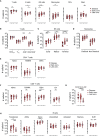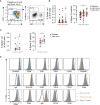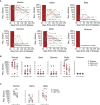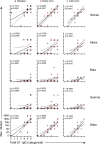Longitudinal Tracking of Immune Responses in COVID-19 Convalescents Reveals Absence of Neutralization Activity Against Omicron and Staggered Impairment to Other SARS-CoV-2 Variants of Concern
- PMID: 35359969
- PMCID: PMC8964088
- DOI: 10.3389/fimmu.2022.863039
Longitudinal Tracking of Immune Responses in COVID-19 Convalescents Reveals Absence of Neutralization Activity Against Omicron and Staggered Impairment to Other SARS-CoV-2 Variants of Concern
Abstract
Evaluating long-term protection against SARS-CoV-2 variants of concern in convalescing individuals is of high clinical relevance. In this prospective study of a cohort of 46 SARS-CoV-2 patients infected with the Wuhan strain of SARS-CoV-2 we longitudinally analyzed changes in humoral and cellular immunity upon early and late convalescence. Antibody neutralization capacity was measured by surrogate virus neutralization test and cellular responses were investigated with 31-colour spectral flow cytometry. Spike-specific, isotype-switched B cells developed already during the disease phase, showed a memory phenotype and did not decrease in numbers even during late convalescence. Otherwise, no long-lasting perturbations of the immune compartment following COVID-19 clearance were observed. During convalescence anti-Spike (S1) IgG antibodies strongly decreased in all patients. We detected neutralizing antibodies against the Wuhan strain as well as the Alpha and Delta but not against the Beta, Gamma or Omicron variants for up to 7 months post COVID-19. Furthermore, correlation analysis revealed a strong association between sera anti-S1 IgG titers and their neutralization capacity against the Wuhan strain as well as Alpha and Delta. Overall, our data suggest that even 7 month after the clearance of COVID-19 many patients possess a protective layer of immunity, indicated by the persistence of Spike-specific memory B cells and by the presence of neutralizing antibodies against the Alpha and Delta variants. However, lack of neutralizing antibodies against the Beta, Gamma and Omicron variants even during the peak response is of major concern as this indicates viral evasion of the humoral immune response.
Keywords: B cells; antibodies; delta; omicron; protection; spike; variants of concern.
Copyright © 2022 Odak, Schultze-Florey, Hammerschmidt, Ritter, Willenzon, Friedrichsen, Ravens, Sikora, Bayir, Gutierrez Jauregui, Bernhardt, Stankov, Cossmann, Hansen, Krey, Cornberg, Koenecke, Behrens, Bošnjak and Förster.
Conflict of interest statement
The authors declare that the research was conducted in the absence of any commercial or financial relationships that could be construed as a potential conflict of interest.
Figures





Similar articles
-
Wild-type SARS-CoV-2 neutralizing immunity decreases across variants and over time but correlates well with diagnostic testing.Front Immunol. 2023 Feb 8;14:1055429. doi: 10.3389/fimmu.2023.1055429. eCollection 2023. Front Immunol. 2023. PMID: 36845123 Free PMC article.
-
Serum Fc-Mediated Monocyte Phagocytosis Activity Is Stable for Several Months after SARS-CoV-2 Asymptomatic and Mildly Symptomatic Infection.Microbiol Spectr. 2022 Dec 21;10(6):e0183722. doi: 10.1128/spectrum.01837-22. Epub 2022 Nov 14. Microbiol Spectr. 2022. PMID: 36374040 Free PMC article.
-
Pre-Omicron Vaccine Breakthrough Infection Induces Superior Cross-Neutralization against SARS-CoV-2 Omicron BA.1 Compared to Infection Alone.Int J Mol Sci. 2022 Jul 12;23(14):7675. doi: 10.3390/ijms23147675. Int J Mol Sci. 2022. PMID: 35887023 Free PMC article.
-
Immunogenicity of convalescent and vaccinated sera against clinical isolates of ancestral SARS-CoV-2, Beta, Delta, and Omicron variants.Med. 2022 Jun 10;3(6):422-432.e3. doi: 10.1016/j.medj.2022.04.002. Epub 2022 Apr 14. Med. 2022. PMID: 35437520 Free PMC article.
-
Neutralizing antibodies to SARS-CoV-2 Omicron variant after third mRNA vaccination in health care workers and elderly subjects.Eur J Immunol. 2022 May;52(5):816-824. doi: 10.1002/eji.202149785. Epub 2022 Mar 25. Eur J Immunol. 2022. PMID: 35312186 Free PMC article.
Cited by
-
The breadth of the neutralizing antibody response to original SARS-CoV-2 infection is linked to the presence of Long COVID symptoms.J Med Virol. 2023 Nov;95(11):e29216. doi: 10.1002/jmv.29216. J Med Virol. 2023. PMID: 37988251 Free PMC article.
-
Comprehensive antibody and cytokine profiling in hospitalized COVID-19 patients in relation to clinical outcomes in a large Belgian cohort.Sci Rep. 2023 Nov 7;13(1):19322. doi: 10.1038/s41598-023-46421-4. Sci Rep. 2023. PMID: 37935729 Free PMC article.
-
SARS-CoV-2 Spike and Nucleocapsid Antibody Response in Vaccinated Croatian Healthcare Workers and Infected Hospitalized Patients: A Single Center Cohort Study.Viruses. 2022 Sep 4;14(9):1966. doi: 10.3390/v14091966. Viruses. 2022. PMID: 36146773 Free PMC article.
-
Fully understanding the efficacy profile of the COVID-19 vaccination and its associated factors in multiple real-world settings.Front Immunol. 2022 Oct 25;13:947602. doi: 10.3389/fimmu.2022.947602. eCollection 2022. Front Immunol. 2022. PMID: 36389777 Free PMC article. Review.
-
A Bispecific Antibody Targeting RBD and S2 Potently Neutralizes SARS-CoV-2 Omicron and Other Variants of Concern.J Virol. 2022 Aug 24;96(16):e0077522. doi: 10.1128/jvi.00775-22. Epub 2022 Aug 2. J Virol. 2022. PMID: 35916510 Free PMC article.
References
-
- Centers for Disease Control and Prevention . SARS-CoV-2 Variant Classifications and Definitions. Available at: https://www.cdc.gov/coronavirus/2019-ncov/variants/variant-classificatio... (Accessed on: 05 January 2022).
Publication types
MeSH terms
Substances
Supplementary concepts
LinkOut - more resources
Full Text Sources
Medical
Miscellaneous

